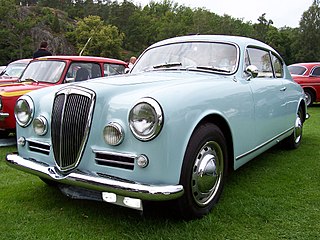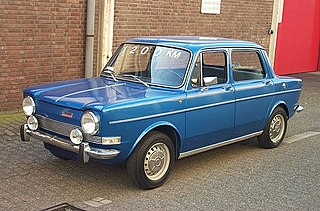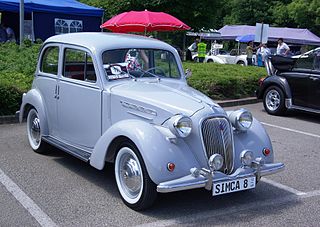
The Fiat 128 is a transverse front-engine, front wheel drive small family car manufactured and marketed by Fiat from 1969 to 1985 as a two- or four-door sedan, three- or five-door station wagon as well as two- or three-door coupé. The 128 running gear and engine, reconfigured for a mid-engined layout, were used in the Fiat X1/9 sports car.

The Fiat 124 is a small family car manufactured and marketed by Italian company Fiat between 1966 and 1974. The saloon superseded the Fiat 1300 and spawned station wagon, four-seater coupé, and two-seater convertible variants.

The Fiat 500 is an economy / city car that was manufactured and marketed by Fiat Automobiles from 1957 until 1975. It was sold as a two-door semi-convertible or saloon car and as a three-door panel van or estate car.

The Fiat 500, commonly known as "Topolino", is an Italian city car produced and manufactured by Fiat from 1936 to 1955.

A grand tourer (GT) is a type of car that is designed for high speed and long-distance driving with performance and luxury. The most common format is a front-engine, rear-wheel-drive two-door coupé with either a two-seat or a 2+2 arrangement. Grand tourers are often the coupé derivative of luxury saloons or sedans. Some models, such as the Ferrari 250 GT, Jaguar E-Type, and Aston Martin DB5, are considered classic examples of gran turismo cars.

The Fiat 600 is a small, rear-engined city car and economy family car made by Italian carmaker Fiat from 1955 to 1969 — offered in two-door fastback sedan and four-door Multipla mini MPV body styles. The 600 is considered a pop icon of the Italian economic miracle, and the three-row seating Multipla, though diminutive and odd-looking, is seen as one the first mass-produced minivans.

The Fiat 1100 is a small family car produced from 1953 until 1969 by the Italian manufacturer Fiat. It was an all-new unibody replacement for the Fiat 1100 E, which descended from the pre-war, body-on-frame Fiat 508 C Balilla 1100. The 1100 was changed steadily and gradually until being replaced by the new Fiat 128 in 1969. There were also a series of light commercial versions of the 1100 built, with later models called the Fiat 1100T, which remained in production until 1971. The Fiat 1100 D also found a long life in India, where Premier Automobiles continued to build the car until the end of 2000.

The Auto Avio Costruzioni 815 was the first car to be fully designed and built by Enzo Ferrari. Legal issues with former associates Alfa Romeo prevented Ferrari from creating the Ferrari marque. The 815 raced at the 1940 Brescia Grand Prix, where both entries failed to finish due to engine problems. One of the cars was later scrapped, while the other is currently in a car collection in Italy.

The Simca 1100 is a series of French compact family cars – mainly C-segment hatchbacks, but also a compact wagon and popular delivery vans – built for over 15 years by French car-maker Simca, from 1967 through 1982/1985. There was even a very early 'hot hatchback', and a family cross-over: the Matra Simca Rancho. The hatchbacks were replaced by the Simca-Talbot Horizon.

The Fiat 508 Balilla was a compact car designed and produced by Fiat from 1932 to 1937. It was, effectively, the replacement of the Fiat 509, although production of the earlier model had ceased back in 1929. It had a three-speed transmission, seated four, and had a top speed of about 50 mph (80 km/h). It sold for 10,800 lire. About 113,000 were produced.

The Fiat 850 is a small rear-engine, rear-wheel-drive car manufactured and marketed by Italian car manufacturer Fiat from 1964 to 1973.

Dante Giacosa was an Italian automobile designer and engineer responsible for a range of Italian automobile designs — and for refining the front-wheel drive layout to an industry-standard configuration. He has been called the deus ex machina of Fiat.

The Fiat 1300 and Fiat 1500 are a series of front-engine, rear-drive automobiles manufactured and marketed by Fiat from 1961 to 1967, replacing the Fiat 1400 and Fiat 1200 coupé, spyder and cabriolet. The 1300 and 1500 were essentially identical to each other except for their engine displacement, as indicated by their model names, and were offered in sedan/saloon, station wagon, convertible and coupé body styles which shared little mechanically with the other body styles except the 1500 engine.

The Fiat Turbina was a gas turbine-powered concept car built by Italian car manufacturer Fiat in 1954.

The Fiat 518, also called Fiat Ardita, was a model of car produced by Italian car manufacturer Fiat between 1933 and 1938. The name "Ardita" was also used on the six-cylinder engined and more expensive Fiat Ardita 2500 or 527.

The Simca 1000, or Simca Mille in French, is a small, boxy rear-engined four-door saloon, manufactured for 18 years by French automaker Simca, from 1961 to 1978.

The Fiat 8V is a V8-engined sports car produced by the Italian car manufacturer Fiat from 1952 to 1954. The car was introduced at the 1952 Geneva Motor Show. The Fiat 8V got its name because at the time of its making, Fiat believed Ford had a copyright on "V8". With 114 made, the 8V was not a commercial success but did well in racing. Apart from the differential, the car did not share any parts with the other Fiats; many parts were made by Siata and they used them for their cars. The 8V was developed by Dante Giacosa and the stylist Luigi Rapi. The engine was a V8 originally designed for a luxury sedan, but that project was stopped.

The Simca 8 is a small family car built by Simca and sold in France between November 1937 and 1951, available as a saloon, coupé or cabriolet. It was a rebadged Fiat 508C "nuova Balilla" made at Fiat's Simca plant in Nanterre, France.

The Fiat 1500 was a six-cylinder car produced by the Fiat from 1935 to 1950. It was one of the first cars tested in a wind tunnel, following the Chrysler Airflow produced one year earlier. The streamlined styling achieved an aerodynamic efficiency unequalled before it in a touring car and disproved the thesis aerodynamic cars would not sell.

Fiat 1200 was the name of three distinct models produced by Italian car manufacturer Fiat, all based on Fiat 1100 mechanicals. The first two were introduced in 1957, and replaced the TV variants at the top of the Fiat 1100 range: the 1200 Granluce, an upmarket small four-door saloon derived from the 1100, and the 1200 Spyder, an update of the previous 1100 TV Trasformabile 2-door roadster. The 1200 Granluce was discontinued in 1961 when larger Fiat saloons were introduced, while the 1200 Trasformabile/Spyder was replaced in 1959 by the 1200 Cabriolet. This was a new Pininfarina design, later developed into the 1200 and 1500 Cabriolets.





























